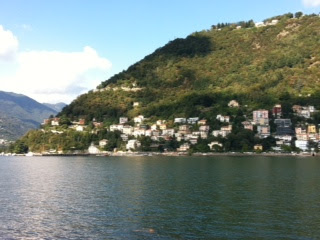Studying Italian is not the same thing as learning Italian, at least not for me. A pretty good student back in the day (well, there was that gaping math/science deficit), last October I rendered an Italian language instructor speechless with my confusing spoken word, which is something like EngliSpanItalian. Sometimes, I speak two or three words in perfect Italian and then... mid-sentence silence.
Part of my challenge is approaching the Italian language like I'm cooking from scratch, constructing sentences from carefully chosen basic elements. Since the linguistic cupboard is bare, I resorted to the communication equivalent to fast food-- memorizing a list of expressions.
Not Lost in Translation is an English to Italian MP3 download featuring a list of situation-specific expressions. In "shopping", we hear a woman with a Scottish accent ask, "Do you have a smaller size?" and a woman repeats the phrase in Italian. Each expression and corresponding translation is repeated three times to groovy 60's lounge music that makes me want to drink a Martini, which also may impede the learning process.
While these canned expressions may lack nuance, they allow me to ask directions, order a meal, and buy a pair of shoes. And knowing how to say "He's a wanker" is pretty useful in any language. Overall, canned expressions are very helpful. If you recite the correct phrase from your memory, that is.
I noticed this shortcoming when a waiter gave me directions to the pharmacy instead of the house red I thought I had ordered. No big problem, I thanked him and his expression relaxed when I ordered the vino rosso, no doubt relieved I wasn't about to throw up in his station.
Which brings me to the swear words and pick-up lines segments of Not Lost in Translation. Phrases like "Do you have a light?" and "Can I offer you a drink?" merit memorizing and are expressions which can do little damage in any given setting. But what does it say about a language culture that includes the pick-up line, "I'm horny. Can you help me?", and is it really a good idea to memorize it? Gotta love the Italians.
I remove the earbuds when the "I'm horny. Can you help me?" translation is in que for fear that if committed to memory I will mistakenly recite it when what I mean to ask is for the cab driver to take me to the airport.
You can sample it on iTunes: itunes.apple.com/us/album/the-coolest-language-phrases/id343159055








































